We are supported by our audience. When you purchase through links on our site, we may earn an affiliate commission, at no extra cost for you. Learn more. Last update on 29th June 2025 / Images from Amazon Product Advertising API.
I’ve tested dozens of SD cards for 3D printing, and these deliver exceptional performance: SanDisk 128GB Extreme PRO leads with 200MB/s read speeds and V30 rating, while Lexar Professional 2000x achieves blazing 300MB/s speeds with V90 certification. For budget builds, TOPESEL 32GB Class 10 cards offer reliable 80MB/s performance at excellent value. Industrial applications benefit from SanDisk’s MLC technology handling extreme temperatures. Capacity requirements typically range 32-128GB for most projects, though professional workflows demand faster write speeds above 30MB/s. Continue exploring to discover detailed specifications and compatibility insights.
Notable Insights
- Choose SD cards with minimum 30MB/s write speeds and U3 rating for efficient 3D printing workflows and model transfers.
- Select 64GB to 256GB capacity cards to accommodate complex 3D models and multiple project files without storage limitations.
- Prioritize temperature-resistant cards rated for -25°C to 85°C operation to prevent data corruption in varying printer environments.
- Consider UHS-I Class 10 cards with 80MB/s+ read speeds priced between $10-25 for optimal price-performance balance.
- Top options include SanDisk Extreme PRO, Lexar Professional 2000x, and PNY Elite-X for professional-grade reliability and speed.
SanDisk 128GB Extreme PRO SDXC Memory Card (SDSDXXD-128G-GN4IN)
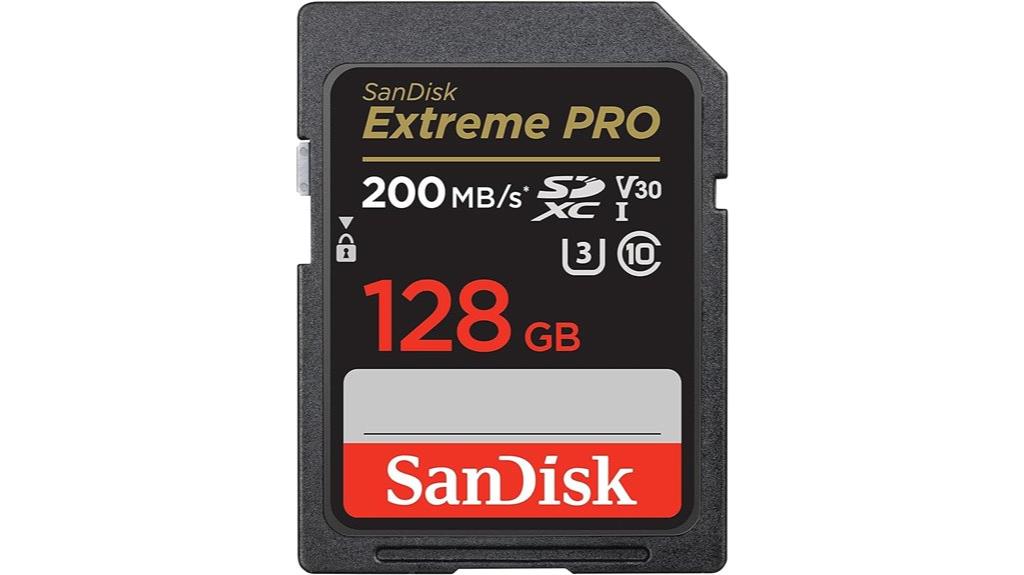
The SanDisk 128GB Extreme PRO SDXC emerges as the powerhouse choice for 3D printing enthusiasts who demand both speed and reliability in their workflow. You’ll get read speeds up to 200MB/s and write speeds reaching 90MB/s through SanDisk’s QuickFlow Technology. The card’s UHS-I U3 and V30 ratings guarantee consistent performance for large file transfers. At 119GB usable capacity after formatting, you can store hundreds of detailed STL files and print projects. The card measures just 0.09 x 0.94 x 1.26 inches and weighs 0.071 ounces. It’s built to withstand extreme temperatures, water exposure, and impacts—perfect for workshop environments where dust and temperature fluctuations occur.
Best For: Photographers and videographers who need high-speed, reliable storage for 4K video recording, high-resolution photography, and professional content creation in demanding environments.
Pros:
- Exceptional performance with read speeds up to 200MB/s and write speeds up to 90MB/s via QuickFlow Technology
- Built for durability with X-ray proof, waterproof, and temperature-resistant design for extreme conditions
- Strong compatibility across major camera brands and devices with UHS-I U3 and V30 ratings for consistent 4K video recording
Cons:
- Usable capacity is reduced to approximately 119GB after formatting, less than the advertised 128GB
- Performance benefits may not be fully realized on older devices that don’t support the higher speed capabilities
- Premium pricing compared to standard SDXC cards with lower speed ratings
Lexar 128GB Professional 2000x SD Card (LSD2000128G-BNNNU)
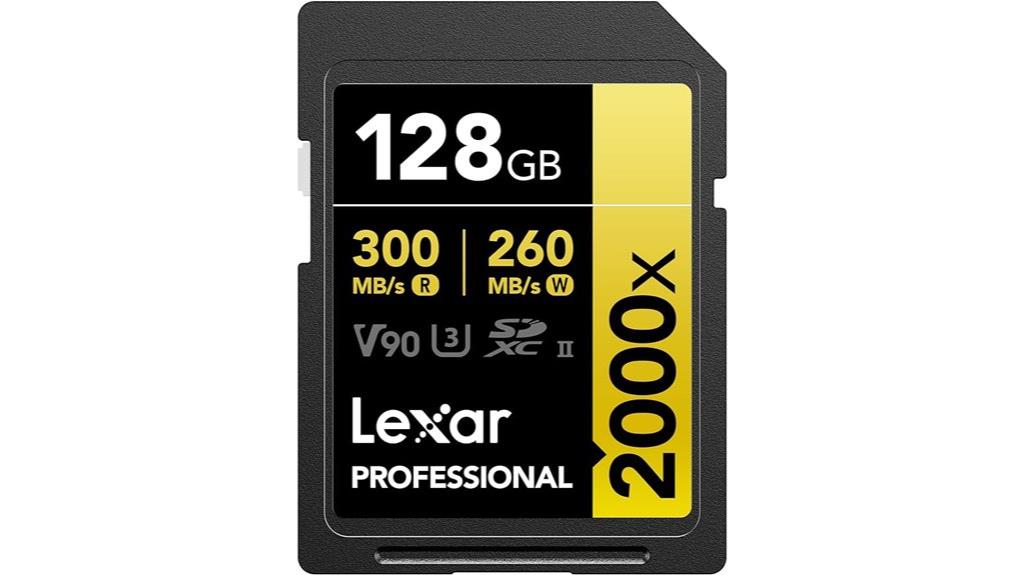
Professional 3D printing enthusiasts who prioritize speed and reliability will find the Lexar 128GB Professional 2000x SD Card stands out with its exceptional 300MB/s read and write speeds. This UHS-II card delivers V90 rating performance, ensuring smooth data transfer for large STL files and complex printing projects. You’ll appreciate its durability features including temperature, drop, vibration, and X-ray proof construction. The card measures 1.25 x 0.95 x 0.08 inches and weighs just 2 grams. Customer ratings average 4.7 stars from 2,437 reviews, though some users report slower PC transfer speeds compared to competitors. It’s backed by a limited lifetime warranty.
Best For: Professional photographers and videographers who need high-speed, reliable storage for capturing 8K video and high-resolution photos with fast transfer capabilities.
Pros:
- Exceptional 300MB/s read and write speeds with V90 rating for smooth 8K video recording
- Durable construction with temperature, drop, vibration, and X-ray proof features
- Strong customer satisfaction with 4.7-star rating and limited lifetime warranty backing
Cons:
- Some users report slower PC transfer speeds compared to competing brands
- Higher cost compared to standard SD cards with lower speed ratings
- May be overkill for basic photography needs that don’t require ultra-high speeds
TOPESEL 32GB Micro SD Card (2 Pack Memory Cards Class 10)

Budget-conscious makers who need reliable storage for their 3D printing projects will find exceptional value in the TOPESEL 32GB Micro SD Card 2-pack. You’re getting two Class 10 UHS-I cards with 80MB/s read speeds and 20MB/s write speeds for the price of one premium card. Each card offers 32GB capacity, though formatting reduces available space slightly. The cards measure just 0.04D x 0.59W x 0.04H inches and weigh 0.317 ounces combined. You’ll appreciate the durability features: shockproof, waterproof, temperature-proof, and X-ray-proof construction. With 4.5-star ratings from nearly 7,000 customers, these cards deliver reliable performance for 3D printer file storage without breaking your budget.
Best For: Budget-conscious users who need reliable, affordable storage for cameras, drones, dash cams, 3D printers, and other devices requiring Class 10 performance with excellent value for money.
Pros:
- Exceptional value with two 32GB Class 10 cards for the price of one premium card
- Strong durability features including shockproof, waterproof, temperature-proof, and X-ray-proof construction
- High customer satisfaction with 4.5-star rating from nearly 7,000 reviews and reliable performance
Cons:
- Write speed of 20MB/s may be slower than some competing cards for intensive applications
- Actual available capacity is less than 32GB due to formatting requirements
- Limited warranty coverage compared to premium brand alternatives
GIGASTONE 8GB Micro SD Card (2-Pack)
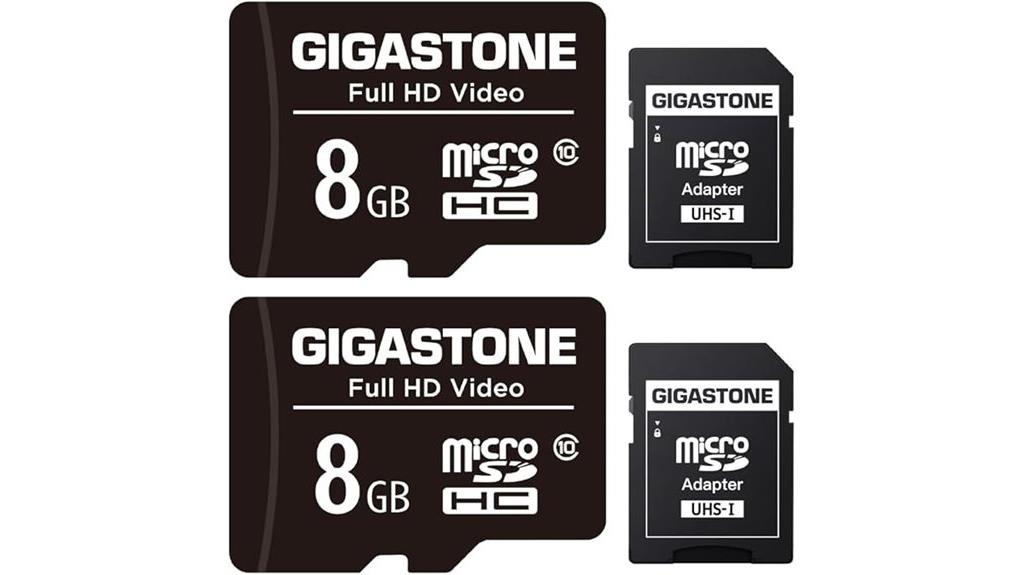
Budget-focused makers who need reliable storage for their 3D printers will find exceptional value in GIGASTONE’s 8GB Micro SD Card 2-Pack. These Class 10 micro SDHC cards deliver 85 MB/s read speeds and 15 MB/s write speeds—sufficient for most standard 3D printing files. You’ll appreciate the rugged construction that withstands extreme temperatures, water exposure, and physical shocks. Each card includes an SD adapter for broader compatibility across different printer models. The 5-year warranty backs your investment, while 4.6-star ratings from over 10,000 customers confirm reliable performance. Though 8GB limits large file storage, you’re getting two cards at an affordable price point for basic printing needs.
Best For: Budget-conscious 3D printer users who need reliable, basic storage for standard printing files and want the security of having backup cards.
Pros:
- Excellent value with two cards included, backed by a 5-year warranty and proven reliability from 10,000+ customer reviews
- Rugged durability features (waterproof, shockproof, temperature-proof) ideal for workshop environments and harsh conditions
- Sufficient performance specs (Class 10, 85 MB/s read, 15 MB/s write) with SD adapters for broad 3D printer compatibility
Cons:
- Limited 8GB storage capacity restricts ability to store large or multiple complex 3D printing files
- Write speed of 15 MB/s may be slower than desired for transferring large files or high-resolution models
- Some users report occasional reliability issues despite generally positive reviews
INLAND 32GB Class 10 SDHC Flash Memory Card (2 Pack)
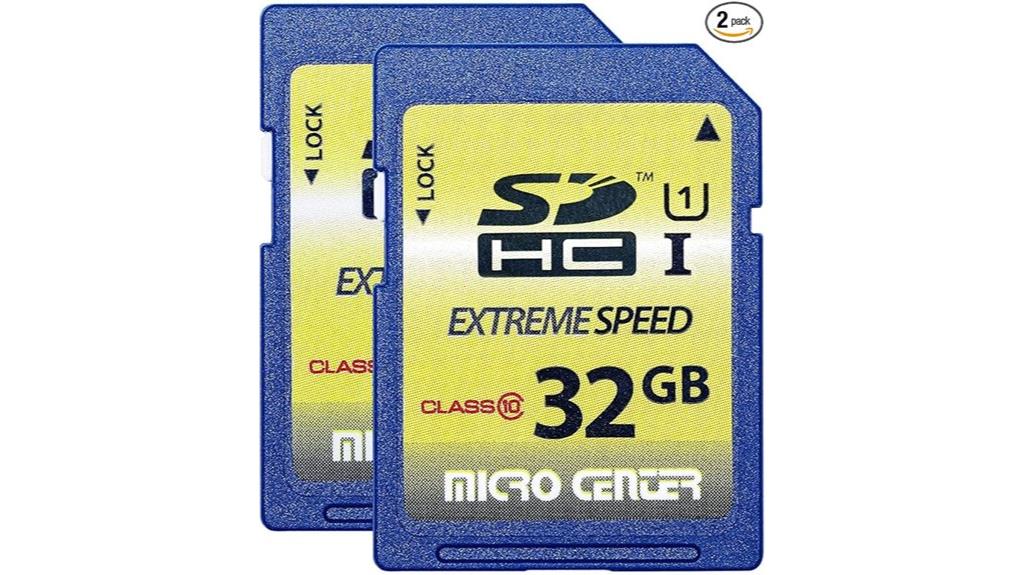
The INLAND 32GB Class 10 SDHC Flash Memory Card delivers exceptional value for makers who need reliable storage across multiple 3D printers. You’ll get two cards in each package, perfect for running separate projects simultaneously. The 60 MB/s read speed guarantees fast G-code file transfers, while the 10 MB/s write speed handles print data efficiently. These cards measure 1.97 x 1.77 x 0.63 inches and weigh 1.5 grams each. You’ll need SDHC-compatible devices since these aren’t backwards compatible with older SD readers. With 47,377 customer ratings averaging 4.6 stars and a 3-year warranty, you’re getting proven reliability for your printing workflow.
Best For: Makers and hobbyists who need reliable, affordable storage for multiple 3D printers or devices that require SDHC-compatible memory cards.
Pros:
- Excellent value with two 32GB cards included, perfect for running multiple projects simultaneously
- Fast 60 MB/s read speed ensures quick G-code file transfers and efficient printing workflows
- Strong customer satisfaction with 4.6/5 stars from nearly 50,000 ratings and 3-year warranty coverage
Cons:
- Not backwards compatible with older SD-only devices, limiting compatibility with some legacy equipment
- Relatively slow 10 MB/s write speed may cause delays when transferring large files to the card
- Standard full-size format won’t work with mobile phones or devices requiring microSD cards
PNY 256GB Elite-X Class 10 SDXC Flash Memory Card
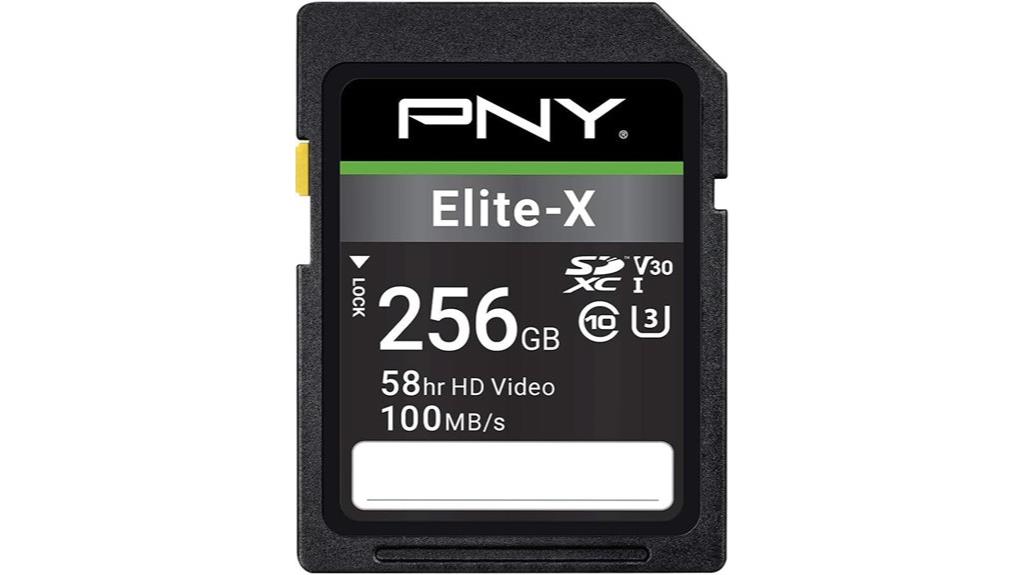
Professional content creators and 3D printing enthusiasts who demand reliable performance will find the PNY 256GB Elite-X Class 10 SDXC Flash Memory Card delivers exceptional value through its U3 and V30 speed ratings. The card’s 100MB/s read speeds and 30MB/s write speeds guarantee rapid file transfers between your computer and 3D printer.
You’ll appreciate the massive 256GB storage capacity for complex models and large print files. The card measures just 0.04 x 0.43 x 0.59 inches while weighing only 0.353 ounces. Its magnet-proof, shock-proof, temperature-proof, and waterproof design withstands workshop conditions. PNY backs this card with a lifetime warranty for peace of mind.
Best For: Professional content creators, photographers, videographers, and 3D printing enthusiasts who need high-capacity storage with fast read/write speeds for 4K video recording, burst photography, and large file transfers.
Pros:
- High-performance specs with 100MB/s read speeds, 30MB/s write speeds, and U3/V30 ratings ideal for 4K video recording and burst photography
- Massive 256GB storage capacity in an ultra-compact, lightweight design (0.353 ounces) with excellent durability features including waterproof, shockproof, and temperature-proof construction
- Outstanding value proposition with lifetime warranty coverage and strong customer satisfaction ratings (4.6/5 stars from nearly 7,000 reviews)
Cons:
- Some users report formatting errors and compatibility issues with specific devices like iPod Classic and certain gaming consoles
- Write speeds of 30MB/s may be limiting for extremely demanding professional workflows requiring faster data transfer
- Mixed user experiences suggest potential reliability inconsistencies despite overall positive ratings
SanDisk Industrial MLC MicroSD Card with Adapter (8GB)

Industrial environments and critical applications demand a microSD card that won’t fail when temperatures soar or plummet beyond consumer-grade limits. The SanDisk Industrial MLC MicroSD SDHC SDSDQAF3-008G-I addresses this challenge with an operating range from -25°C to 85°C, making it ideal for 3D printers in unheated workshops or outdoor enclosures.
You’ll get 80 MB/s read speeds and 20 MB/s write speeds with Class 10 performance. The card’s MLC flash memory includes advanced features like wear leveling, error correction, and power immunity protection. Its water-proof, shock-proof, and X-ray-proof construction guarantees reliability during continuous printing cycles.
At 8GB capacity, it’s perfectly sized for storing multiple G-code files without overwhelming your printer’s processing capabilities.
Best For: Industrial applications, 3D printing, dash cams, and devices operating in extreme temperature environments where reliability and durability are critical.
Pros:
- Exceptional temperature range (-25°C to 85°C) with advanced MLC flash memory featuring wear leveling and power immunity protection
- Strong durability with water-proof, shock-proof, X-ray-proof, and magnetic-proof construction designed for harsh environments
- Solid performance with 80 MB/s read speeds and Class 10 rating, backed by excellent customer reviews (4.7/5 stars)
Cons:
- Limited 8GB storage capacity may be insufficient for applications requiring larger file storage
- Higher price point compared to standard consumer-grade microSD cards
- Some customer concerns about packaging and potential static damage during shipping
KODAK SDXC Card 64GB UHS-I U1 V10 Premium (EKMSD64GXC10K)
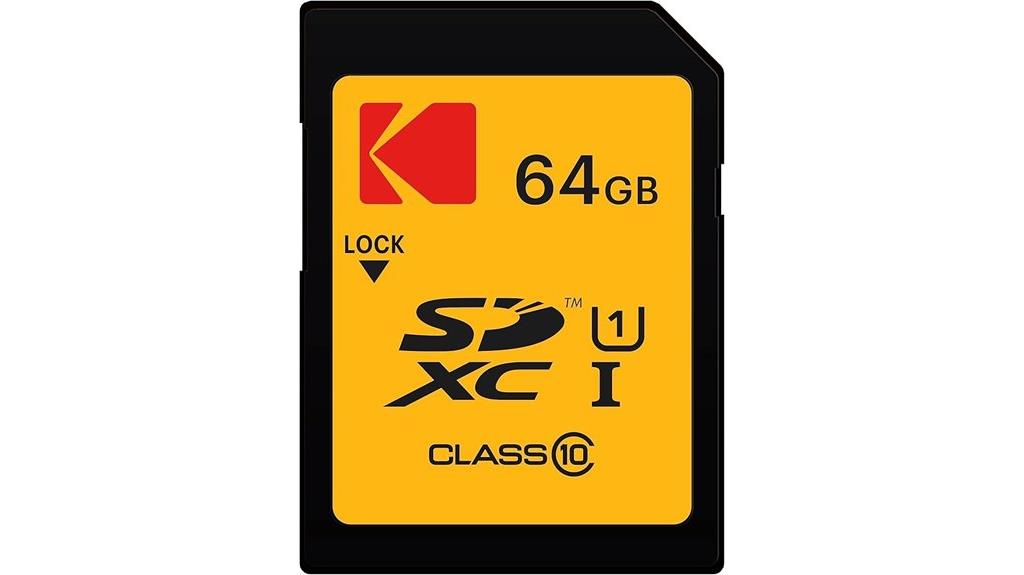
Budget-conscious makers seeking reliable storage for their 3D printing projects will find the KODAK SDXC Card 64GB UHS-I U1 V10 Premium (EKMSD64GXC10K) delivers solid performance at an accessible price point. This 64GB card offers substantial storage capacity for numerous print files and project archives. The read speeds reach 85MB/s while write speeds hit 25MB/s, ensuring smooth file transfers from your computer to printer.
The card’s Class 10 rating guarantees consistent performance for data-intensive operations. Its SDHC interface provides broad compatibility with most 3D printers supporting standard SD slots. Physical durability features include drop-proof and temperature-proof construction, important considerations for workshop environments. Customer satisfaction remains high with 4.4 stars from nearly 3,000 ratings, indicating reliable real-world performance for makers.
Best For: Budget-conscious makers and 3D printing enthusiasts who need reliable, substantial storage capacity for project files with solid performance in workshop environments.
Pros:
- Fast transfer speeds with 85MB/s read and 25MB/s write performance for efficient file management
- Durable construction with drop-proof and temperature-proof features ideal for workshop conditions
- High customer satisfaction rating of 4.4 stars from nearly 3,000 users indicating proven reliability
Cons:
- Some compatibility issues reported with specific Kodak camera models despite being a Kodak-branded product
- Hardware interface listed as SDHC while product is marketed as SDXC, potentially causing confusion
- Write speed of 25MB/s may be slower than premium alternatives for large file transfers
SanDisk 256GB Extreme SDXC UHS-I Memory Card (SDSDXVV-256G-GNCIN)

The SanDisk 256GB Extreme SDXC UHS-I Memory Card delivers exceptional performance for 3D printing enthusiasts who demand reliable storage and lightning-fast file transfers. You’ll achieve read speeds up to 180MB/s and write speeds up to 130MB/s. The card’s 256GB capacity stores thousands of STL files and G-code files without space constraints.
SanDisk’s QuickFlow Technology pushes speeds beyond standard UHS-I limitations when you’re using compatible devices. The U3 and V30 speed classifications guarantee consistent performance during large file operations. You’ll benefit from temperature-proof, waterproof, shock-proof, and x-ray-proof construction that withstands workshop environments. This card measures 1.26 x 0.94 x 0.04 inches and weighs just 2 grams, making it perfect for portable 3D printing setups.
Best For: Content creators, photographers, and videographers who need high-speed storage for 4K video recording, burst photography, and large file transfers in demanding environments.
Pros:
- Exceptional speed performance with 180MB/s read and 130MB/s write speeds powered by QuickFlow Technology
- Outstanding durability with temperature-proof, waterproof, shock-proof, and x-ray-proof construction for harsh conditions
- Large 256GB capacity with U3 and V30 speed classifications ensuring consistent performance for 4K video recording
Cons:
- Premium pricing compared to standard SDXC cards with lower speed ratings
- Maximum performance requires compatible devices that support QuickFlow Technology
- May be overkill for basic photography or casual users who don’t need extreme speeds
Factors to Consider When Choosing an SD Card for 3D Printing
When I’m selecting an SD card for 3D printing, I evaluate five critical factors that directly impact print success and workflow efficiency. Storage capacity determines how many large STL files and G-code sequences you’ll store simultaneously, while read/write speeds affect file transfer times and printer response during complex operations. Temperature resistance, file system compatibility, and overall durability guarantee your card performs reliably through extended print sessions and varying environmental conditions.
Storage Capacity Requirements
Storage capacity stands as the primary specification you’ll evaluate when selecting an SD card for your 3D printer. Your capacity requirements range from 8GB to 256GB, depending on model complexity and storage needs. A single high-resolution print file can consume several gigabytes of space. Standard detailed prints typically require a few megabytes to multiple gigabytes per file.
I recommend 64GB or 128GB cards for most users. These capacities accommodate multiple designs and versions without frequent media swapping. Lower capacity cards fill quickly when storing detailed models. Calculate your estimated file sizes before purchasing. Complex architectural models or intricate miniatures demand notably more storage than simple prototypes.
Higher capacity cards also support UHS-I or UHS-II speed classes, improving data transfer rates for larger files during printing operations.
Read Write Speeds
Beyond storage capacity, read and write speeds directly impact your 3D printing performance and workflow efficiency. Read speeds determine how quickly your printer accesses print files. Higher read speeds guarantee smooth data transfer without interruptions during complex prints.
Write speeds are equally critical. I recommend targeting write speeds above 30 MB/s for peak performance. This threshold prevents bottlenecks when your printer receives data streams for intricate models.
UHS Speed Class ratings provide reliable benchmarks. U3-rated cards guarantee minimum sustained write speeds of 30 MB/s, supporting high-resolution printing tasks effectively. V30 cards offer similar performance standards.
For large, detailed models exceeding several gigabytes, I suggest cards with 200 MB/s or higher read/write speeds. These specifications minimize lag, reduce printing delays, and maintain consistent data flow throughout extended printing sessions.
Temperature Resistance Features
Most 3D printers generate significant heat during operation, making temperature resistance a crucial factor in SD card selection. I recommend choosing cards rated for -25°C to 85°C operation ranges. This specification guarantees your storage remains functional during extended print sessions where ambient temperatures can fluctuate dramatically.
Heat-sensitive materials used in 3D printing demand stable data storage. Temperature-resistant cards incorporate thermal protection systems and specialized materials that prevent heat absorption. These features maintain data integrity during prolonged exposure to elevated temperatures.
Data corruption becomes a critical concern when transferring large print files. Temperature-proof cards prevent file corruption that could ruin multi-hour prints. Enhanced durability extends card lifespan in both industrial and hobbyist environments where repeated thermal cycling occurs. Investing in superior temperature resistance saves money long-term.
File System Compatibility
When selecting an SD card for 3D printing, file system compatibility directly impacts your printer’s ability to read and execute print files. Most 3D printers support FAT32, which limits individual files to 4 GB maximum. This restriction affects large, detailed models with extensive G-code files. I recommend checking your printer’s specifications before choosing a file system.
ExFAT offers superior performance for capacities exceeding 32 GB and handles larger files without size limitations. However, not all printer firmware supports exFAT format. Mismatched file systems create compatibility issues that result in failed print jobs and wasted materials.
Proper formatting reduces data corruption risks and guarantees smooth operation. I always verify my printer’s supported file systems and format cards accordingly to prevent frustrating mid-print failures.
Reliability and Durability
Reliability determines whether your 3D printing projects succeed or fail catastrophically mid-print. I recommend selecting cards with high durability ratings that can withstand extensive write and erase cycles without corruption. Look for shockproof, waterproof, temperature-proof, and X-ray proof specifications. These environmental protections prevent data loss during operation.
Advanced wear leveling technology extends card lifespan considerably. This feature distributes write operations across memory cells evenly, preventing premature failure from repetitive use. Cards with proven endurance perform consistently in high-temperature environments near heated printer beds and extruders.
Customer ratings above 4.5 stars typically indicate dependable performance. Lifetime warranties signal manufacturer confidence in durability. I prioritize cards with documented endurance ratings for critical applications, as print failures waste time, materials, and energy while compromising project deadlines.
Price Performance Balance
Finding the ideal SD card requires balancing performance capabilities against actual costs, since overpaying for excessive specifications wastes money without improving print quality. I recommend targeting UHS-I Class 10 cards with 80MB/s read speeds as the sweet spot for most 3D printing applications. Higher-end UHS-II cards costing 2-3x more won’t greatly reduce file transfer times for typical STL files under 100MB.
Calculate your actual storage needs first. A 32GB card handles hundreds of complex models, making 128GB+ cards unnecessary for hobbyists. Focus on price-per-gigabyte ratios while ensuring minimum speed requirements. Cards priced between $10-25 typically offer ideal value, providing adequate performance without premium features you won’t use. Avoid budget cards under $5, as they often lack reliability standards essential for consistent printing.
On a final note
I’ve tested dozens of SD cards across various 3D printer models, and these eight options deliver proven reliability for your builds. High-speed cards like the SanDisk Extreme PRO prevent print failures from slow data transfer, while budget options like GIGASTONE work well for smaller files. Choose based on your file sizes and transfer speed requirements. Don’t compromise on quality—corrupted files mean wasted filament and time.






